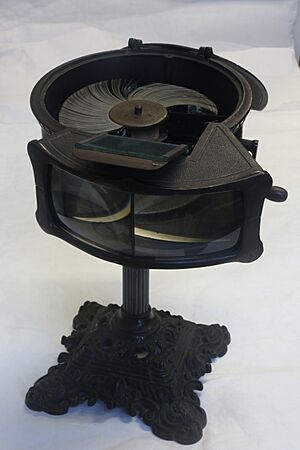Kinora facts for kids
The Kinora was an early device that showed moving pictures. It was like a small flip book that you could watch at home. The famous French inventors Auguste and Louis Lumière created it in 1895. They also invented the Cinematograph around the same time. The Kinora was officially patented in February 1896.
Contents
What Was the Kinora and How Did It Work?
A Home Movie Viewer
The Kinora was a smaller version of another device called the mutoscope. It worked a lot like a Rolodex or a flip book. It used many black and white photos printed on strong, flexible cards. These cards were attached to a round core.
To watch a movie, you would turn a handle. This made the pictures flip over very quickly, one by one, against a small peg. When the pictures flipped fast enough, it looked like they were moving! You watched these moving pictures through a special eyepiece.
From Invention to Market
The Lumière brothers were very busy with their Cinematograph. The Cinematograph became very popular. Because of this, the Lumières did not focus much on the Kinora. Instead, they shared their idea for the Kinora with a company called Gaumont.
Around 1900, Gaumont started selling the Kinora. They also sold about one hundred different movie reels for it.
The Kinora in the UK
In 1898, a company called The British Mutoscope & Biograph Co. bought the rights to the Kinora for the UK. However, they did not start selling the machine in the UK until 1902. Once it was available, the Kinora became very popular there.
More than 12 different viewer models were made. Over 600 different movie reels were also produced.
Making Moving Portraits
In 1900, Biograph built a special studio in London. Here, they filmed moving portraits of families and individuals. At first, they made small flip books called Bio-Gems. These had 60 pictures in the standard Mutoscope size.
Later, in 1903, they started offering a Kinora reel portrait service. This meant you could have your own moving portrait made for your Kinora viewer.
New Developments and Decline
In May 1907, the chairman of Biograph, W.T. Smedley, started a new company called Kinora Limited in London. This company introduced the first Kinora camera for people to use at home in 1908.
This camera used rolls of photographic paper or celluloid that were one inch wide. People could send these rolls to the company to be developed into Kinora reels. The company also advertised a "Kinora Grand." This larger version could hold 1,000 pictures, each measuring 2 1/2 inches by 3 inches.
By 1914, public interest in the Kinora began to fade. At this time, movies shown on big cinema screens were becoming much more exciting. The Kinora Limited factory in London burned down in 1914. The company decided not to rebuild it, as the Kinora was no longer as popular.


